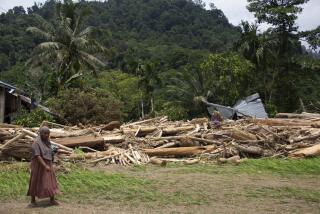Indonesia Fiscal Crisis Now Seen as Less Severe
A controversial World Bank report concludes that Asiaâs financial meltdown exacted far less suffering on Indonesia than forecast, a finding that bodes well for the global economy but could jeopardize efforts to funnel relief to the millions who were casualties of the dramatic downturn.
The report, which will be released Monday, suggests that the impact of the Asian crisis may not be as severe as feared. Together with signs of a real recovery in South Korea and Thailand, these new findings give hope that the U.S. and other major economies have not been as hard hit by the regionâs turmoil as earlier predicted.
But although that may be good economic news, it could slow the flow of money to the Indonesian government, which has received more than $50 billion in pledges of support from the International Monetary Fund and individual governments since the financial turbulence first rocked Asiaâs stock and currency markets in 1997.
Indeed, some in the international aid community fear that the report will make it harder to get donations for a country where millions are unemployed and impoverished, even if the level of suffering doesnât live up to the worst doomsday predictions.
Indonesiaâs importance to the world economy extends well beyond its $100-billion global trading relationships, including $12 billion in business with the U.S. Its economic well-being is intricately linked to Japan, the worldâs second-largest economy and which has invested billions in Indonesian high-technology, paper and chemical sectors.
And Indonesiaâs political stability is critical to its Southeast Asian neighbors Singapore and Malaysia, which fear a repeat of last Mayâs bloody riots that drove thousands across their borders and led to the ouster of former President Suharto that month. Of particular concern is the potential for increased violence in the run-up to elections in June.
Scott Guggenheim, a World Bank social scientist in Washington, said the Indonesian economy had proven to be very âresilientâ and its population far more resourceful than expected given the currency collapse, price hikes and escalating social unrest that has claimed hundreds of lives since President B.J. Habibie took power last year.
The bank has not yet conducted similar studies on other hard-hit Asian countries, but the reportâs findings are certainly good news for a region whose economies are closely linked through cross-border trade and investment.
âWhile Indonesia is suffering a severe crisis, it is not the universal disaster some would have it,â states a draft of the World Bank report, which will be delivered Monday in Jakarta, the Indonesian capital, at a meeting of donor countries.
Richard Drobnick, an Indonesia expert and vice provost at the University of Southern California, warns that there are some effects that cannot be easily measured, such as the cost of diminished expectations and lost opportunities.
âFalling into poverty is not what causes social revolution, itâs changed expectations,â he said. âThe expectation of these people was that theyâd never be hungry again.â
Yet the World Bank report argues that the dramatic levels of poverty, unemployment and school dropout rates reported by the Indonesian government and others are vastly inflated because of inadequate data and improper assumptions about the crisis, which has had its greatest impact among Indonesiaâs urban middle class.
In an effort to produce a comprehensive analysis of the street-level effects of the crisis, the World Bank report looked at national data collected by the Indonesian government, UNICEF, the Rand Corp. and others in August and September of 1997 and 1998.
The report challenges predictions that Indonesiaâs change in fortunes would lead to a âlost generationâ of Indonesians.
For example, the bank states that the number of Indonesians living in âabsolute povertyâ in the worldâs fourth-most-populous country increased 3% last year compared with 1997. Earlier forecasts put the figure as high as 37%.
On the employment side, Indonesiaâs jobless rates were less than 7%, compared to previous forecasts of as high as 22%. The report explained that one major reason for the lower numbers was the willingness of Indonesians to take any job, even as menial laborers or street vendors, just to make ends meet.
The World Bankâs reassessment of Indonesiaâs condition has touched off controversy in the international aid community.
Stephen Woodhouse, a Jakarta-based UNICEF official, questioned the bankâs conclusions and cited evidence of sharp increases in maternal deaths and malnutrition as proof that Indonesiaâs situation is dire.
Some privately questioned whether the World Bank is pushing a more optimistic spin on Indonesia to counter criticism of its sister agency, the IMF. The international agency is accused of aggravating the crisis in Indonesia by imposing too many harsh conditions in exchange for a $43-billion bailout package.
âEven if the crisis is less than some of the figures indicate, then that is hardly reason for complacency because the crisis is there and itâs very uncertain what the future will bring,â said Imelda Henkin, director of the Asia-Pacific division of the U.N. Population Fund. The fund released a report this week stating that the financial crisis had disproportionately harmed women and girls in Southeast Asia.
Indonesia is hardly ready to be taken off the critical list. The economy has started to show signs of improvement--such as a stronger currency and stock market--but it is still expected to contract by at least 3% this year after a 15% slowdown in 1998. The government is predicting a $10-billion shortfall in revenue this year.
âEven the level of assistance provided last year based on horrific figures was not enough to cover the social impacts,â said Mahendra Siregar, an Indonesian Embassy spokesman in Washington. âIf some people reduce their assistance, Iâm just nervous worse things will happen.â
From the beginning, Asiaâs unexpected economic downturn and the virulent global contagion that followed confounded the experts.
Anecdotal accounts about the desperate straits of those in the region abounded, but there has been little hard data to measure the decline.
The World Bank blames the confusion of statistics on the failure of many, including the government in Jakarta, to recognize the unique nature of the crisis, whose harshest effects were felt among the urban middle class.
Unlike a natural disaster, the Asian financial crisis was selective, taking its greatest toll on the regionâs financial, real estate and service sectors and others tied to the global economy.
The hardest-hit were Indonesiaâs middle-income earners, who were most likely to have mortgages or loans that escalated after the currency, the rupiah, plunged 80% against the dollar. Yet they also had savings accounts and assets to sell, making them less vulnerable to sliding into poverty.
These Indonesians were more likely to place a high value on education, keeping their children in school while making sacrifices elsewhere.
Indonesia also benefited from being less industrialized than its neighbors. Although the economy of Jakarta and the heavily urbanized island of Java was substantially affected, there were rural areas such as Sulawesi where the farmers have received a boost from expanded export sales thanks to the currency decline.
But Woodhouse, UNICEFâs Indonesia director, warns that the pockets of extreme suffering could easily spread if the economy does not improve quickly.
He said reports from UNICEF field offices throughout Indonesia show measurable declines in the health and well-being of women and children.
He cited a study of six major East Java hospitals over the past year that reported a 60% increase in the maternal mortality rate. He said that would translate into 13,000 maternal deaths annually in Indonesia, which would be 26 times the maternal death rate in the U.S.
Across Asia, rising unemployment, inflation and weakened currencies have forced families to cut back on basic necessities.
Woodhouse said anemia is on the rise, and milk and egg consumption in the Jakarta area has dropped 50% since the crisis hit.
âBetween 1976 and 1996, the medical students had to learn about severe malnutrition from textbooks because it no longer existed in Indonesia,â he said during a visit to Los Angeles last week. âNow, doctors are seeing a growing number of children who are severely malnourished.â
More to Read
Sign up for Essential California
The most important California stories and recommendations in your inbox every morning.
You may occasionally receive promotional content from the Los Angeles Times.










